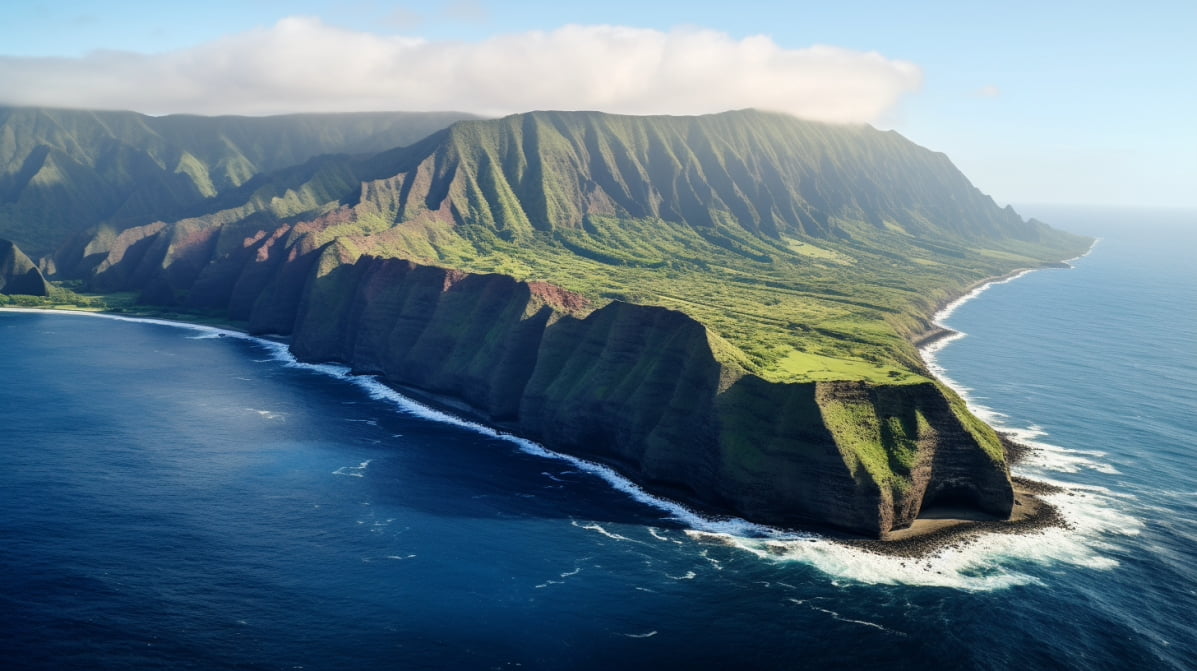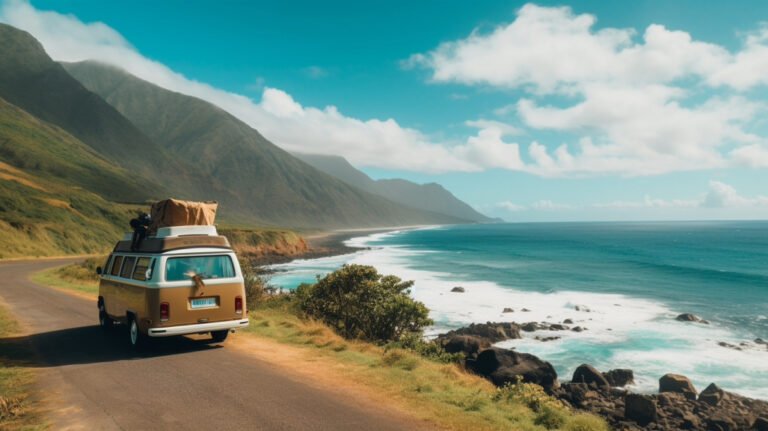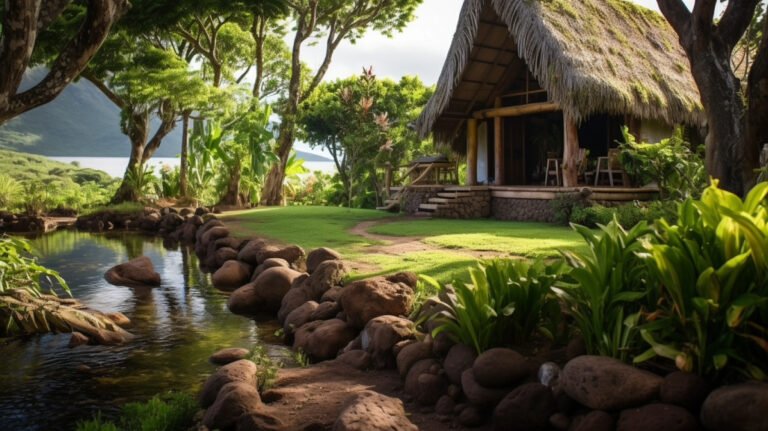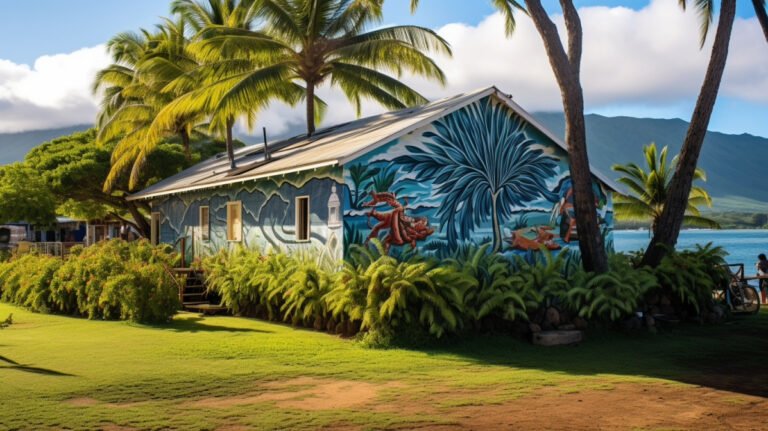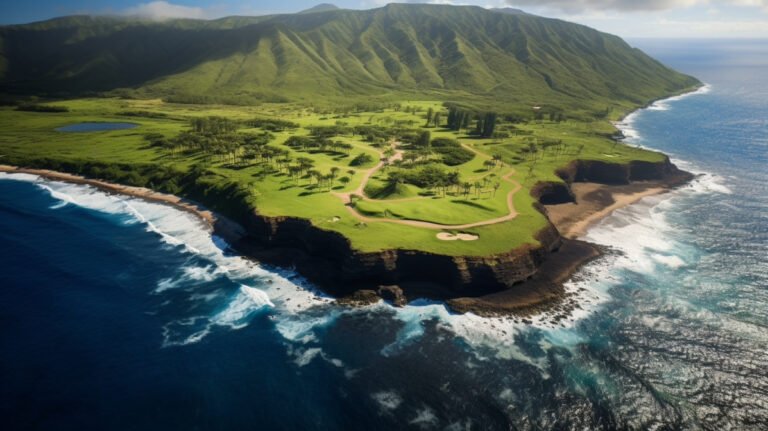Unveiling Molokai: Paradise Found 🌺
Molokai is a gorgeous Hawaiian island with a unique geography that sets it apart from the rest of the archipelago. Its stunning landscapes, diverse climate zones, and abundant natural resources make it an ideal destination for outdoors enthusiasts and nature lovers.
Key Takeaways:
- Molokai is a Hawaiian island with a unique geography that sets it apart from the rest of the archipelago.
- Molokai is a perfect destination for outdoors enthusiasts and nature lovers due to its stunning landscapes, diverse climate zones, and abundant natural resources.
Molokai Island: An Overview of its Geographic Location
Molokai is an island located in the central Pacific, part of the Hawaiian archipelago. It is the fifth largest island in the chain, covering 260 square miles, with a length of 38 miles and a width of 10 miles at its widest point.
Molokai is located between the islands of Oahu and Maui, with Lanai to the west and Kahoolawe to the south. The island can be accessed by air or by ferry from Maui.
The island’s geographic location is significant in terms of its natural resources and historic role in Hawaiian culture. Molokai’s rugged landscape and remote location have allowed it to maintain its natural beauty and traditional way of life.
Unveiling Molokai’s Landscape
Molokai’s landscape is a spectacular mix of diverse terrain, ranging from soaring mountains to scenic valleys and breathtaking coastlines. The unique geological features of the island have resulted in stunning scenery that is sure to awe every visitor.
The Mountains of Molokai
The mountains of Molokai are a treat for hikers and adventurers alike. The highest peak on the island is Kamakou, which rises to an elevation of 4,961 feet. Visitors can soak in the panoramic views of the island from the top of the mountain.
The Valleys of Molokai
The valleys of Molokai are just as impressive as its mountains. The Halawa Valley is a popular destination for visitors who want to witness the island’s natural splendor up close. The valley features cascading waterfalls, lush greenery, and pristine streams.
The Coastline of Molokai
The coastline of Molokai is a sight to behold, with its rugged cliffs and serene beaches. One of the most famous stretches of coastline is the Kalaupapa Peninsula. The peninsula is situated on the northern side of the island and features dramatic sea cliffs that rise to a height of 3,000 feet.
The Waterfalls of Molokai
Molokai’s waterfalls are among the island’s most magnificent geological features. The most famous waterfall is the Mooula Falls, which cascades down a 250-foot drop. Visitors can take a leisurely hike to the falls and enjoy a refreshing dip in its cool waters.
The spectacular landscape of Molokai is a testament to the island’s unique geography. Its topographic features have shaped a stunning array of scenery, making it a natural wonder that is second to none.
The Unique Topography of Molokai
Molokai’s landscape boasts a range of distinct topographic features that set it apart from the other Hawaiian islands. One of the most notable among them is the sea cliffs, located on the island’s northern shore. These cliffs rise dramatically out of the ocean as high as 3,600 feet, making them some of the tallest in the world. Visitors can take helicopter tours to experience the breathtaking views of the sea cliffs.
Another unique feature of Molokai’s topography is the Kalaupapa Peninsula. This isolated area is surrounded by the world’s tallest sea cliffs and was once a place of refuge for those affected by Hansen’s disease, also known as leprosy. The peninsula is accessible only by hiking, mule ride, or airplane, and visitors must obtain a permit to enter.
The eastern end of Molokai is home to the Halawa Valley, a lush and verdant area featuring two prominent waterfalls, Mooula Falls and Hipuapua Falls. The valley is rich in cultural history and is believed to be one of the first settlements on the island.
Meanwhile, the Kamakou Preserve covers the majority of the mountainous interior of Molokai. This forested area is home to diverse plant and animal species, including several that are endemic to Hawaii.
The Sea Cliffs of Molokai
“The sea cliffs are like no place on earth. It’s as if you are flying over the edge of the world.”
-Molokai Visitor
| Location | Height | Accessibility |
|---|---|---|
| North Shore of Molokai | Up to 3,600 feet | Helicopter tours |
The Kalaupapa Peninsula
“Stepping onto the Kalaupapa Peninsula is like stepping back in time. It’s a place of deep history and significance.”
-Kalaupapa Visitor
| Location | Height | Accessibility |
|---|---|---|
| North Shore of Molokai | Surrounded by 3,600-foot sea cliffs | Hike, mule ride, or airplane; permit required |
The Halawa Valley
“The Halawa Valley feels like a secret garden, hidden away from the world. It’s a must-see for anyone visiting Molokai.”
-Molokai Visitor
| Location | Height | Accessibility |
|---|---|---|
| Eastern End of Molokai | Features Mooula Falls and Hipuapua Falls | Hiking |
The Kamakou Preserve
“The Kamakou Preserve is like walking through a time capsule. It’s amazing to see how untouched and ancient the landscape is.”
-Molokai Visitor
| Location | Height | Accessibility |
|---|---|---|
| Mountainous Interior of Molokai | Encompasses over 2,774 acres | Hiking |
Exploring Molokai’s Geographical Features
Molokai’s geography offers a stunning array of natural wonders to explore, from cascading waterfalls to unspoiled beaches. Let’s take a closer look at some of the island’s unique geographical features.
The Stunning Waterfalls of Molokai
Molokai is home to some of the most spectacular waterfalls in Hawaii. Among the most famous is the 250-foot-tall Papalaua Falls. This stunning waterfall can be accessed via a moderate hike through lush vegetation. On the east end of the island, the 150-foot-tall Moaula Falls can be found deep within the Halawa Valley and is considered one of the most beautiful waterfalls in Hawaii.
The Unspoiled Beaches of Molokai
Molokai’s beaches are beloved by locals and visitors alike for their unspoiled beauty. Papohaku Beach is one of the island’s most famous beaches, with its three miles of pristine shoreline and stunning sunsets. For a quieter experience, head to Kapukahehu Beach, also known as Dixie Maru Beach, which offers calm waters perfect for swimming and snorkeling.
The Verdant Forests of Molokai
Molokai’s forests are home to a variety of plant and animal life, including rare and endemic species. Kamakou Preserve, a 2,774-acre forest preserve in the mountains of east Molokai, is home to more than 250 species of native plants, including ferns, mosses, and flowering plants. It’s also an important refuge for native birds such as the Hawaiian Honeycreeper.
The Mighty Cliffs of Molokai
Molokai’s towering sea cliffs are some of the highest in the world and a breathtaking sight to behold. The cliffs, which reach heights of up to 3,000 feet, can be best viewed from the ocean on a guided boat tour. Another must-see destination is the Kalaupapa Peninsula on the north shore of Molokai, which is surrounded on three sides by imposing cliffs that separate it from the rest of the island.
As you can see, Molokai’s geography is a wonderland of natural beauty just waiting to be explored.
Molokai’s Natural Resources: A Rich Bounty
Molokai boasts an abundance of natural resources that have played a significant role in shaping its culture and economy. From the fertile soil to the surrounding ocean, the island’s natural bounty is a vital asset to its people.
| Natural Resource | Significance |
|---|---|
| Fishing | The surrounding ocean provides a plentiful supply of fish, which has been a staple in the traditional Hawaiian diet for centuries. The fishing industry also plays a crucial role in the island’s economy. |
| Agriculture | Molokai’s fertile soil and ideal climate conditions have made agriculture an essential part of the island’s economy. Crops such as taro, sweet potato, and coffee are grown on the island and are sold locally and exported to markets all over the world. |
| Forestry and Woodworking | The island’s forests are home to a diverse range of flora and fauna, including native species that are endemic to Hawaii. The wood from indigenous trees, such as koa and ohia, is used for traditional woodwork and crafts. |
| Mineral Resources | Molokai’s volcanic origins have left behind valuable resources such as clay, sand, and gravel. |
The island’s rich natural resources have played an integral role in the development of Molokai’s culture and economy. However, it is also imperative that these resources are conserved and protected for future generations to enjoy.
Molokai Climate: From Sun-Kissed Shores to Rainy Valleys
Molokai’s diverse geography gives rise to a varied climate, with distinct temperature and rainfall patterns observed across different regions of the island. The eastern side of Molokai experiences more rainfall, with the valleys receiving as much as 400 inches of rainfall annually, while the western side, which is more arid, receives less than 20 inches of rainfall per year.
The coastal regions of Molokai are characterized by a tropical climate, with temperatures ranging from 70°F to 85°F (21°C to 29°C) all year round. The island experiences trade winds that blow eastward and provide a pleasant cooling effect on the coast.
Due to its diverse microclimates, Molokai offers visitors a unique opportunity to experience different weather arrangements in one location. While some guests may enjoy the sunshine and warmth of the coast, others may opt for a hike through the island’s lush valleys and waterfalls, experiencing the refreshing mist and cool temperatures the environment offers.
Molokai Climate Zones
The climate zones on Molokai can be broadly classified into three categories:
| Climate Zone | Location | Characteristics |
|---|---|---|
| Tropical Humid | East Molokai | High rainfall, lush flora, and fauna |
| Tropical Arid | West Molokai | Low rainfall, arid, and less vegetative cover |
| Temperate | Upcountry Molokai | Cooler temperatures, greenery, and diverse crops |
The temperate climate zone is located in the higher elevations of the island and experiences cooler temperatures year-round. This region has a slightly different flora and fauna, with forested areas and fields of diverse crops such as coffee, papaya, and macadamia nuts.
Whether it’s the mild temperatures of the coast, the lush greenery of the valleys, or the vibrant agriculture in the upcountry, Molokai’s climate is sure to captivate visitors.
Molokai’s Volcanic Origins and Geological History
Molokai’s unique geography can be traced back to its volcanic origins, which have shaped the island’s landscape over millions of years. The island was formed by two shield volcanoes, the East Molokai and West Molokai, that erupted and flowed lava to create the landmass.
The eruptions resulted in the formation of a diverse range of features, from towering sea cliffs to lush valleys and rolling hills. Molokai’s topography reflects the different stages of volcanic activity, with the youngest and most active areas located in the east and southeast, and the older, eroded features in the west and northwest.
The Sea Cliffs of Molokai
The sea cliffs of Molokai are a spectacular sight, rising more than 3,000 feet above the ocean. They were formed by the erosion of the island’s volcanic slopes by wind and waves, which created sheer cliffs and narrow valleys. The cliffs are home to a variety of seabirds, including the endangered Hawaiian petrel, and have been designated a National Natural Landmark.
The Kalaupapa Peninsula
The Kalaupapa Peninsula is another distinctive feature of Molokai’s geography. It is a narrow strip of land that juts out from the island’s northern coast, and was formed by the eruption of a separate volcano. The peninsula is surrounded by the towering sea cliffs and was once the site of a leper colony, which is now a National Historical Park.
Molokai’s geological history is a fascinating story that has shaped its unique landscape and natural resources. Today, the island’s natural beauty continues to attract visitors from all over the world, who come to explore its diverse geography and experience its rich cultural heritage.
Environmental Conservation Efforts on Molokai
Molokai is a special place with a unique geography, and its natural resources need to be protected. The Molokai Land Trust is a non-profit organization dedicated to preserving the island’s natural and cultural resources.
The trust has been working tirelessly to conserve Molokai’s natural beauty since 2001. Their efforts include the protection of endangered species, reforestation, and the rehabilitation of degraded lands. They also manage many conservation areas on the island, such as the Kamakou Preserve, which is home to many unique and rare species.
In addition to the Molokai Land Trust, other organizations and individuals are working towards preserving the island’s geography. The Nature Conservancy and the Department of Land and Natural Resources both have projects on Molokai that aim to protect the island’s natural resources for future generations.
The Molokai Community Service Council is another organization that works to promote environmental conservation on the island. They have ongoing projects like the Molokai Clean-up, and they work to educate residents and visitors about responsible waste management and environmental awareness.
While these organizations are doing their part to protect Molokai’s geography, it’s crucial for visitors to do their part as well. The Leave No Trace Center for Outdoor Ethics offers guidelines for responsible outdoor recreation that should be followed while exploring Molokai’s natural beauty. Visitors should take care to leave no trace of their visit and respect the island’s delicate ecosystems.
It’s essential to protect Molokai’s natural resources and unique geography, and individuals and organizations alike are working together to ensure that the island’s beauty is preserved for generations to come.
Sustainable Tourism and Responsible Exploration
As Molokai continues to attract visitors from around the world, the importance of sustainable tourism practices and responsible exploration becomes increasingly evident. The island’s unique geography and natural resources are vulnerable to damage and depletion, making it crucial for visitors to appreciate and respect Molokai’s delicate ecosystem.
One way to support sustainable tourism on Molokai is to choose eco-friendly accommodations and tour operators. Many hotels and vacation rentals on the island utilize renewable energy sources and limit their environmental impact, while some tour companies specialize in educational eco-tours that promote conservation and responsible exploration.
Visitors can also do their part by following the “leave no trace” principles when hiking, camping, or enjoying other outdoor activities on Molokai. This includes carrying out all trash and waste, respecting wildlife, and avoiding damage to natural features.
Another way to explore Molokai responsibly is by engaging with the local community and supporting their sustainable initiatives. For example, visitors can participate in community service projects, attend cultural events, and purchase locally made products. By doing so, tourists can help promote a more sustainable and equitable tourism industry on Molokai.
Conclusion: Embracing the Beauty of Molokai’s Geography
In conclusion, Molokai boasts breathtaking natural landscapes from sea cliffs to waterfalls that create a visually stunning and diverse geography. This magnificent scenery draws visitors from across the globe. However, it is crucial that we preserve Molokai’s natural wonders for future generations through sustainable tourism and conservation.
Appreciate the island’s beauty by getting out into nature responsibly. Support local eco-initiatives and explore Molokai’s wondrous landscape without leaving a permanent mark. Let’s protect the significance of the island’s landscapes to its culture and economy.
Immerse yourself in the awe-inspiring vistas and scenery of this island paradise. Download the Molokai Travel Guide Molokai Travel Guide to start planning your sustainable Molokai adventure. Help keep Molokai’s extraordinary natural geography untouched for the future.

